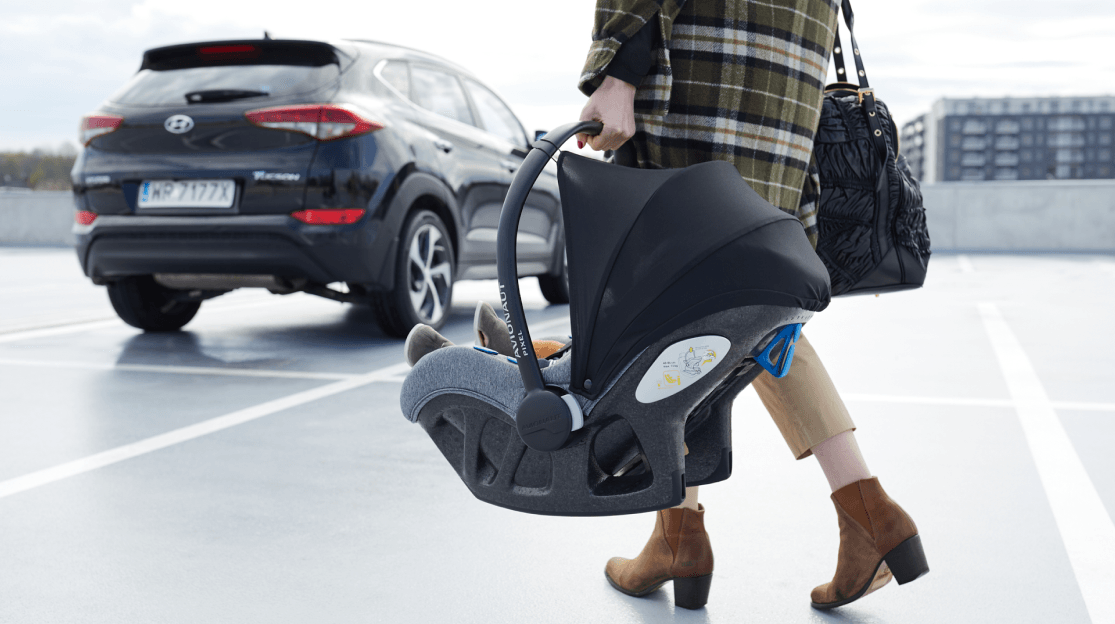
Safety on the road to your dreams
In the children’s world, dreams have no limits. Whether a toddler dreams of a new Lego set, a red tabby cat or a flight into space, they sincerely and deeply believe that sooner or later this dream will come true. Do not let one moment and perhaps a foolish decision made on the road turn those childhood dreams into much more mundane and, sadly, sadder events. Learn the 10 rules for safe car travel with your child and travel together (safely!) toward your dreams.

Contents:
- The basis for safety on the road: the child car seat
- Safety and comfort: the right clothing
- Bottle projectile: securing free-standing objects
- Snacks only at rest stops
- Travel comfort = relaxed toddlers and calmer parents
- Your child’s safety is in your hands
The basis for safety on the road: the child car seat
There are no safe journeys without a safe child seat. And this applies to children of every age: whether newborns, toddlers, 3-year-olds or 7-year-olds – until the child reaches 150 cm in height.
Why does a child seat matter so much? The reason is… anatomy. Car belts are designed to protect the adult. Their positioning means that only a person of an adequate height can use them in the correct way, with the belt running from the middle of the shoulder, through the middle of the sternum and below the iliac spines. Only the correct positioning of the belt ensures that it can work as intended and fulfil the function for which it was designed: the protection of health and life.
This is why children should travel in a child seat until they reach a height of 150 cm – only such a seat offers them the right level of protection. This applies not only to the smallest toddlers, but also to kids who already look ‘grown-up’ enough to theoretically be able to travel on a booster cushion, for example. The seat will provide them with much greater comfort as it guarantees a proper, spine-safe position and a comfortable back support.
RWF seats – as long as possible!
Moreover, toddlers should ride in a rear-facing (RWF) seat until at least the age of 4. If you are in the process of changing the ‘carrier’ (0-13 kg seat), choose this RWF as the next model. It provides a level of safety 5 times greater than forward-facing ones (FWF). When a toddler is travelling backwards, in the event of a sudden road incident – sudden braking, a collision or an accident – the seat absorbs the forces more effectively.
Why is it recommended to travel backwards at least until the age of 4, and preferably for as long as possible? Because at this age, the child’s body is transformed to such an extent that its spine and neck muscles are strengthened. Only when this process is complete, the child can withstand the forces that act on them when an incident occurs on the road.
Safety and comfort: the right clothing
An important rule for safe travel is also associated the proper clothing of the toddler. This is especially important in autumn and winter – on a cold day, do not dress your child in thick, down jackets and overalls as these make it difficult (and sometimes even impossible!) to properly tighten the harness and straps. It is definitely better to cover the baby with a blanket or wrap. Older children can also wear the jacket ‘back to front’ so that the straps are routed underneath.
And in the summer? Choose light, airy clothes made of natural materials such as cotton or linen which allow the skin to ‘breathe’ and facilitate proper thermoregulation.
Bottle projectile: securing free-standing objects
For safety reasons, there should be no loose objects in the car when driving. During rapid braking, even seemingly harmless items such as a bottle of water, crayons or a rattle can turn into a projectile flying with tremendous force and creating danger.
Pack everything you want to keep handy in a bag or secure it in the glove compartment or rear seat pockets. You can also use special organisers attached to the seats.
Snacks only at rest stops
Another cardinal rule for safe driving is: no eating while driving. All it takes is a sharp turn or sudden braking for a toddler to choke on food. That is why you should plan any snacks for when you stop. It is recommended to take breaks every 2-3 hours while travelling.
Travel comfort = relaxed toddlers and calmer parents
Children can really let us know loud and clear that they are uncomfortable while driving. The basis for safe and smooth driving is the comfort of the youngest travellers. The child seat is extremely important: it should be adjusted to fit the child in a way that ensures the correct position for the child’s spine.
This is vital not only for toddlers, but also for older children already travelling in their ‘last’ child seat. A backache or numbness in the legs while driving can be really tiring for a child. At Avionaut, we are well aware of the issue – and that is why we equipped our MaxSpace Comfort System + with solutions that prevent this. Our child seat for older kids offers extra neck support, a profiled shape for spinal support and a deep seat with extra padding to support the thighbones to eliminate leg numbness. All of this ensures that the child naturally adopts an appropriate, healthy position for the musculoskeletal system during travel which translates into comfort. And also allows them to fully enjoy the journey for dreams!
A comfortable child seat matters for another reason. When a child is uncomfortable, they will start to wriggle and squirm, adopting different positions which can have the effect of making driving less safe.
Your child’s safety is in your hands
A safe, comfortable child seat and good preparation are important in terms of travel safety. The most important thing, however, is something else: responsible driving behaviour.
Majority of accidents on the road could be avoided if only all road users stuck to the rules. The most common causes of collisions include:
- excessive speed,
- improper overtaking,
- running a red light,
- failure to give the right of way,
- using the phone while driving,
- maintaining too short distances from other vehicles
- and – unfortunately – intoxicated drivers.
Of course, you have no influence over whether an extremely irresponsible or intoxicated driver comes across your path or whether a pedestrian suddenly steps onto the road. However, driving at an speed appropriate to weather and other conditions and being aware of the dangers can save you from a dangerous situation.
When driving, your child’s safety is in your hands. You can’t prevent all risks on the road but you can minimize their effects when they occur. We encourage Parents to keep this in mind. Getting to the destination 10 minutes earlier or checking this notification on your phone are really thousand times less valuable than being able to make all your child’s dreams come true.
That is why you travel safely – with your child in the right seat, driving at the proper speed, keeping attention to the road and following and a rule of limited trust towards other drivers – whether you are going for everyday errands or chase your biggest dreams.
Related articles



